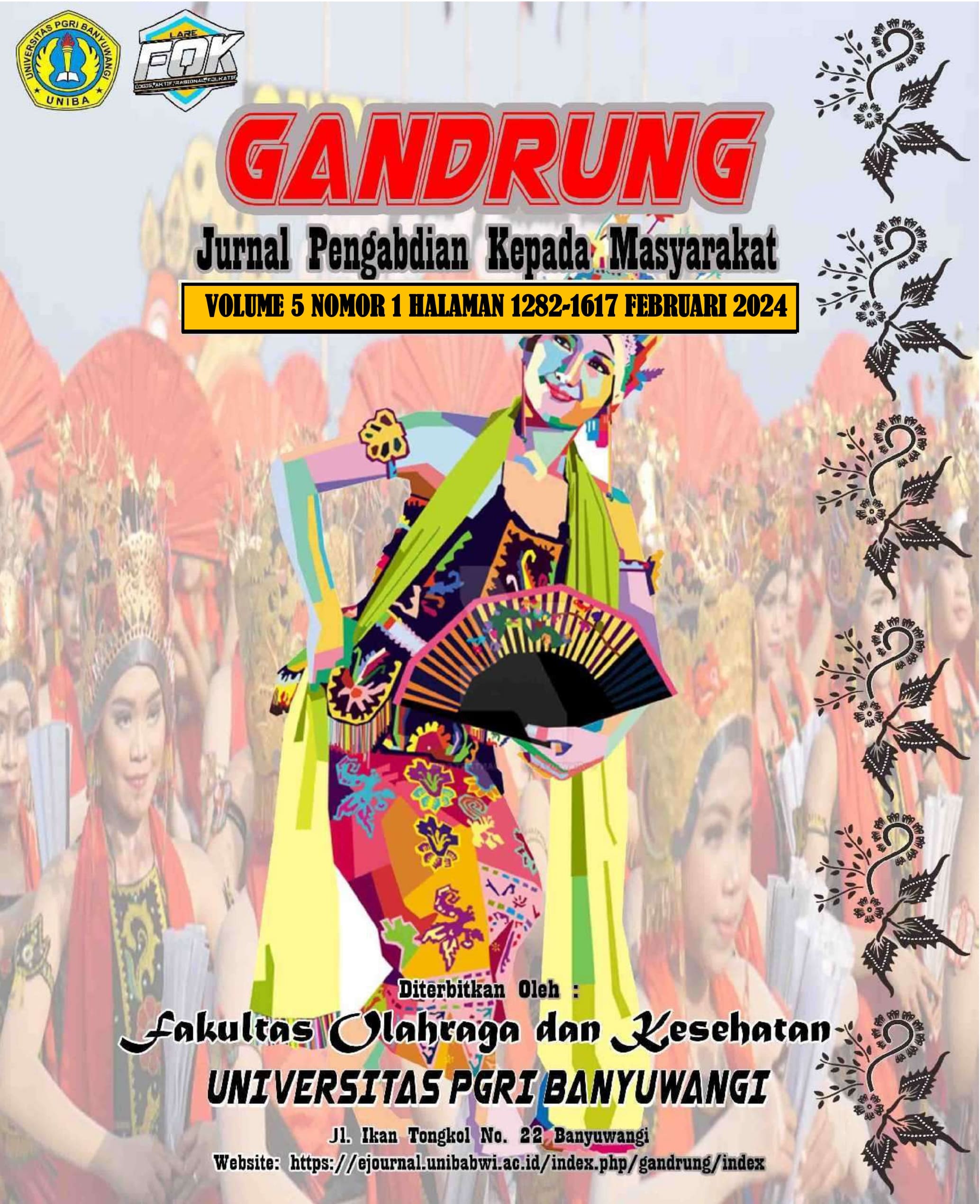Introduction of Fundamental Movement Skill (FMS) in Elementary School
DOI:
https://doi.org/10.36526/gandrung.v5i1.3520Keywords:
Physical Education; Game Activities; Fundamental Movements SkillsAbstract
Students' basic movements begins to develop in the elementary school phase, which must be developed to support the learning of physical education. This dedication discusses several approaches that teachers can use to teach basic movement skills to their students, as well as long-term benefits. Action research methods can be done in a community of sports teachers who will form collaboration with other teachers to find problems and find solutions. Thus, through such methods, participants can receive and implement learning management in support of the identification of sustainable student talents. The results of dedication are: 1) The range of activities carried out, 2) Continuous support, 3) Evaluation and Feedback, 4) Use of Help Tools, 5) Programme Action to Solve Problems. Identifying challenges in the accompaniment process, the leader and the dedication team will identify problems or obstacles encountered by participants in learning basic movement skills. Once the identification is obtained the problem will be formulated in the form of learning reflection for the next meeting. The community service activities, in the implementation of the activities, use playing learning methods and use the learning media that have been modified to have a positive effect on physical, cognitive, and social development. Games and media modified can motivate and attract the interest of children to be willing to train their activity and muscle development, reduce saturation, and improve the child's skills in a fun way.
References
Barnett, L. M., Stodden, D., Cohen, K. E., Smith, J. J., Lubans, D. R., Lenoir, M., Iivonen, S., Miller, A. D., Laukkanen, A., Dudley, D., Lander, N. J., Brown, H., & Morgan, P. J. (2016). Fundamental Movement Skills: An Important Focus. Journal of Teaching in Physical Education, 35(3), 219–225. https://doi.org/10.1123/JTPE.2014-0209
Jaakkola, T., & Washington, T. (2013). The relationship between fundamental movement skills and self-reported physical activity during Finnish junior high school. Https://Doi.Org/10.1080/17408989.2012.690386, 18(5), 492–505. https://doi.org/10.1080/17408989.2012.690386
Light, R. L., & Clarke, J. (2021). Understanding the complexity of learning through movement. Https://Doi.Org/10.1080/17408989.2021.1886266, 26(3), 268–278. https://doi.org/10.1080/17408989.2021.1886266
Mustafa, A. F. (2022). Gambaran pelaksanaan pembelajaran pendidikan jasmani olahraga dan kesehatan (PJOK) selama pandemi covid-19 di sekolah dasar. Jurnal Olahraga Pendidikan Indonesia (JOPI), 1(2), 213–225. https://doi.org/10.54284/jopi.v1i2.25
Ningrum, D. T. M., Chaniago, H., Pasaribu, A. M. N., & Mahyudi, Y. V. (2022). Types of Physical Activity and Sports for teens in Maintaining Physical Fitness in Leisure. Halaman Olahraga Nusantara (Jurnal Ilmu Keolahragaan), 5(2), 661. https://doi.org/10.31851/hon.v5i2.8710
Ningrum, D. T. M., Tangkudung, J., Lubis, J., Riza, A. R., & Denatara, E. T. (2021). The effectiveness of small side games (Ssg) in forearm pass volleyball use application in mobile phone. International Journal of Human Movement and Sports Sciences, 9(4), 642–647. https://doi.org/10.13189/saj.2021.090406
Norito, T. B., Putri, S. A. R., Putra, D. D., & Fajar, M. (2022). Penerapan Cooperative Learning dalam Meningkatkan Keterampilan Gerak Dasar pada Siswa Usia 7-8 Tahun. Jurnal Obsesi : Jurnal Pendidikan Anak Usia Dini, 6(5), 3889–3900. https://doi.org/10.31004/obsesi.v6i5.2507
O’Sullivan, C. Ó., Parker, M., Comyns, T., & Ralph, A. (2020). Enhancing Fundamental Movement Skills: Understanding Student Voices. Journal of Teaching in Physical Education, 40(1), 126–135. https://doi.org/10.1123/JTPE.2019-0170
Petrie, K., & Clarkin-Phillips, J. (2017). ‘Physical education’ in early childhood education: Implications for primary school curricula. Https://Doi.Org/10.1177/1356336X16684642, 24(4), 503–519. https://doi.org/10.1177/1356336X16684642
Sarah, T., & Witarsa, R. (2023). Pengaruh Pembelajaran Kolaborasi terhadap Keterampilan Menirukan Gerak Hewan pada Siswa Sekolah Dasar. Journal of Education Research, 4(1), 226–233. https://doi.org/10.37985/jer.v4i1.152
Sari, M. D., & Nurrochmah, S. (2021). Survei Keterampilan Gerak Dasar pada Siswa Sekolah Menengah Pertama. Sport Science and Health, 3(7), 440–450. https://doi.org/10.17977/um062v3i72021p440-450
Smith, W., Ovens, A., & Philpot, R. (2021). Games-based movement education: developing a sense of self, belonging, and community through games. Https://Doi.Org/10.1080/17408989.2021.1886267, 26(3), 242–254. https://doi.org/10.1080/17408989.2021.1886267
Widiawati, P., Heynoek, F. P., & Amiq, F. (2021). Pelatihan penyusunan training unit bagi guru SD pendidikan jasmani untuk ekstrakulikuler olahraga se Malang Raya. PROMOTIF: Jurnal Pengabdian Kepada Masyarakat, 1(1), 75. https://doi.org/10.17977/um075v1i12021p75-80
Yunus, D. Y. (2019). Analisis Perkembangan Keterampilan Motorik Halus Siswa Kelas II MI Muhammadiyah Kacci-Kacci Kecamatan Bontonompo Kabupaten Gowa.
Downloads
Published
How to Cite
Issue
Section
License
Authors retain copyright and grant the journal right of first publication with the work simultaneously licensed under a Creative Commons Attribution 4.0 International License that allows others to share the work with an acknowledgement of the work's authorship and initial publication in this journal.











.jpg)


_logo.png)


